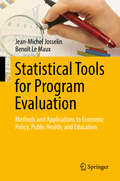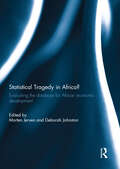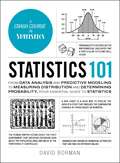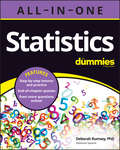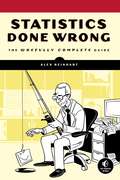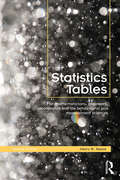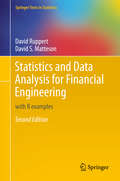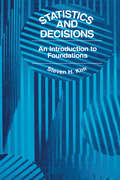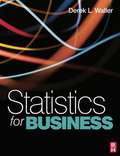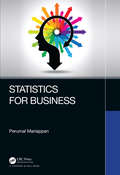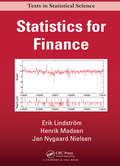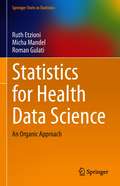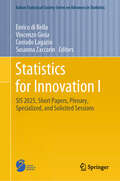- Table View
- List View
Statistical Tools for Program Evaluation: Methods and Applications to Economic Policy, Public Health, and Education
by Jean-Michel Josselin Benoît Le MauxThis book provides a self-contained presentation of the statistical tools required for evaluating public programs, as advocated by many governments, the World Bank, the European Union, and the Organization for Economic Cooperation and Development. After introducing the methodological framework of program evaluation, the first chapters are devoted to the collection, elementary description and multivariate analysis of data as well as the estimation of welfare changes. The book then successively presents the tools of ex-ante methods (financial analysis, budget planning, cost-benefit, cost-effectiveness and multi-criteria evaluation) and ex-post methods (benchmarking, experimental and quasi-experimental evaluation). The step-by-step approach and the systematic use of numerical illustrations equip readers to handle the statistics of program evaluation. It not only offers practitioners from public administrations, consultancy firms and nongovernmental organizations the basic tools and advanced techniques used in program assessment, it is also suitable for executive management training, upper undergraduate and graduate courses, as well as for self-study.
Statistical Tragedy in Africa?: Evaluating the Database for African Economic Development
by Morten Jerven and Deborah JohnstonWhat do we know about economic development in Africa? The answer is that we know much less than we would like to think. This collection assesses the knowledge problem present in statistics on poverty, agriculture, labour, education, health, and economic growth. While diverse in origin, the contributors to this book are unified in two conclusions: the quality and quantity of data needs to be improved; and this is a concern not just for statisticians. Weaknesses in statistical methodology and practice can misinform policy makers, international agencies, donors, the private sector, and the citizens of African countries themselves. This is also a problem for academics from various disciplines, from history and economics to social epidemiology and education policy. Not only does academic work on Africa regularly use flawed data, but many problems encountered in surveys challenge common academic abstractions. By exploring these flaws, this book will provide a guide for scholars, policy makers, and all those using and commissioning surveys in Africa. This book was originally published as a special issue of The Journal of Development Studies.
Statistical and Probabilistic Methods in Actuarial Science (Chapman & Hall/CRC Series in Actuarial Science)
by Philip J. BolandStatistical and Probabilistic Methods in Actuarial Science covers many of the diverse methods in applied probability and statistics for students aspiring to careers in insurance, actuarial science, and finance. The book builds on students' existing knowledge of probability and statistics by establishing a solid and thorough understanding of
Statistical: Ten Easy Ways to Avoid Being Misled By Numbers
by Anthony Reuben'Refreshingly clear and engaging' Tim Harford'Delightful . . . full of unique insights' Prof Sir David SpiegelhalterThere's no getting away from statistics. We encounter them every day. We are all users of statistics whether we like it or not.Do missed appointments really cost the NHS £1bn per year?What's the difference between the mean gender pay gap and the median gender pay gap?How can we work out if a claim that we use 42 billion single-use plastic straws per year in the UK is accurate?What did the Vote Leave campaign's £350m bus really mean?How can we tell if the headline 'Public pensions cost you £4,000 a year' is correct?Does snow really cost the UK economy £1bn per day?But how do we distinguish statistical fact from fiction? What can we do to decide whether a number, claim or news story is accurate? Without an understanding of data, we cannot truly understand what is going on in the world around us.Written by Anthony Reuben, the BBC's first head of statistics, Statistical is an accessible and empowering guide to challenging the numbers all around us.
Statistics 101: From Data Analysis and Predictive Modeling to Measuring Distribution and Determining Probability, Your Essential Guide to Statistics (Adams 101)
by David BormanA comprehensive guide to statistics—with information on collecting, measuring, analyzing, and presenting statistical data—continuing the popular 101 series. Data is everywhere. In the age of the internet and social media, we’re responsible for consuming, evaluating, and analyzing data on a daily basis. From understanding the percentage probability that it will rain later today, to evaluating your risk of a health problem, or the fluctuations in the stock market, statistics impact our lives in a variety of ways, and are vital to a variety of careers and fields of practice. Unfortunately, most statistics text books just make us want to take a snooze, but with Statistics 101, you’ll learn the basics of statistics in a way that is both easy-to-understand and apply. From learning the theory of probability and different kinds of distribution concepts, to identifying data patterns and graphing and presenting precise findings, this essential guide can help turn statistical math from scary and complicated, to easy and fun. Whether you are a student looking to supplement your learning, a worker hoping to better understand how statistics works for your job, or a lifelong learner looking to improve your grasp of the world, Statistics 101 has you covered.
Statistics All-in-One For Dummies
by Deborah J. RumseyThe odds-on best way to master stats. Statistics All-in-One For Dummies is packed with lessons, examples, and practice problems to help you slay your stats course. Develop confidence and understanding in statistics with easy-to-understand (even fun) explanations of key concepts. Plus, you’ll get access to online chapter quizzes and other resources that will turn you into a stats master. This book teaches you how to interpret graphs, determine probability, critique data, and so much more. Written by an expert author and serious statistics nerd, Statistics AIO For Dummies explains everything in terms anyone can understand. Get a grasp of basic statistics concepts required in every statistics course Clear up the process of interpreting graphs, understanding polls, and analyzing data Master correlation, regression, and other data analysis tools Score higher on stats tests and get a better grade in your high school or college classStatistics All-in-One For Dummies follows the curriculum of intro college statistics courses (including AP Stats!) so you can learn everything you need to know to get the grade you need—the Dummies way.
Statistics Done Wrong
by Alex ReinhartScientific progress depends on good research, and good research needs good statistics. But statistical analysis is tricky to get right, even for the best and brightest of us. You'd be surprised how many scientists are doing it wrong.Statistics Done Wrong is a pithy, essential guide to statistical blunders in modern science that will show you how to keep your research blunder-free. You'll examine embarrassing errors and omissions in recent research, learn about the misconceptions and scientific politics that allow these mistakes to happen, and begin your quest to reform the way you and your peers do statistics.You'll find advice on:–Asking the right question, designing the right experiment, choosing the right statistical analysis, and sticking to the plan–How to think about p values, significance, insignificance, confidence intervals, and regression–Choosing the right sample size and avoiding false positives–Reporting your analysis and publishing your data and source code–Procedures to follow, precautions to take, and analytical software that can helpScientists: Read this concise, powerful guide to help you produce statistically sound research. Statisticians: Give this book to everyone you know.The first step toward statistics done right is Statistics Done Wrong.
Statistics For Business And Economics
by Terry Sincich P. George Benson James McClaveThirteenth Edition, Statistics for Business and Economics introduces statistics in the context of contemporary business. Emphasizing statistical literacy in thinking, the text applies its concepts with real data and uses technology to develop a deeper conceptual understanding. Examples, activities, and case studies foster active learning while emphasizing intuitive concepts of probability and teaching readers to make informed business decisions. The Thirteenth Edition continues to highlight the importance of ethical behavior in collecting, interpreting, and reporting on data, while also providing a wealth of new and updated exercises and case studies.
Statistics For Business: Decision Making And Analysis
by Robert A. Stine Dean P. FosterUnderstand Business. Understand Data. The 3rd Edition of Statistics for Business: Decision Making and Analysis emphasizes an application-based approach, in which readers learn how to work with data to make decisions. In this contemporary presentation of business statistics, readers learn how to approach business decisions through a 4M Analytics decision making strategy—motivation, method, mechanics and message—to better understand how a business context motivates the statistical process and how the results inform a course of action. Each chapter includes hints on using Excel, Minitab Express, and JMP for calculations, pointing the reader in the right direction to get started with analysis of data.
Statistics Tables: For Mathematicians, Engineers, Economists and the Behavioural and Management Sciences
by Henry R. NeaveFor three decades, Henry Neave’s Statistics Tables has been the gold standard for all students taking an introductory statistical methods course as part of their wider degree in a host of disciplines including mathematics, economics, business and management, geography and psychology. The period has seen a large increase in the level of mathematics and statistics required to achieve these qualifications and Statistics Tables has helped several generations of students meet their goals. All the features of the first edition are retained including the full range of best-known standard statistical techniques, as well as some lesser-known methods that can be hard to track down elsewhere. The explanatory introductions to each section have been updated and the second edition benefits from the inclusion of a valuable and comprehensive new section on an approach to simple but powerful investigation of process data. This will help the book continue in its position as the prime statistical reference for all students of mathematics, engineering and the social sciences, and everyone who needs effective methods for analysing data.
Statistics and Data Analysis for Financial Engineering
by David Ruppert David S. MattesonThe new edition of this influential textbook, geared towards graduate or advanced undergraduate students, teaches the statistics necessary for financial engineering. In doing so, it illustrates concepts using financial markets and economic data, R Labs with real-data exercises, and graphical and analytic methods for modeling and diagnosing modeling errors. These methods are critical because financial engineers now have access to enormous quantities of data. To make use of this data, the powerful methods in this book for working with quantitative information, particularly about volatility and risks, are essential. Strengths of this fully-revised edition include major additions to the R code and the advanced topics covered. Individual chapters cover, among other topics, multivariate distributions, copulas, Bayesian computations, risk management, and cointegration. Suggested prerequisites are basic knowledge of statistics and probability, matrices and linear algebra, and calculus. There is an appendix on probability, statistics and linear algebra. Practicing financial engineers will also find this book of interest.
Statistics and Data Visualization Using R: The Art and Practice of Data Analysis
by David S. BrownDesigned to introduce students to quantitative methods in a way that can be applied to all kinds of data in all kinds of situations, Statistics and Data Visualization Using R: The Art and Practice of Data Analysis by David S. Brown teaches students statistics through charts, graphs, and displays of data that help students develop intuition around statistics as well as data visualization skills. By focusing on the visual nature of statistics instead of mathematical proofs and derivations, students can see the relationships between variables that are the foundation of quantitative analysis. Using the latest tools in R and R RStudio® for calculations and data visualization, students learn valuable skills they can take with them into a variety of future careers in the public sector, the private sector, or academia. Starting at the most basic introduction to data and going through most crucial statistical methods, this introductory textbook quickly gets students new to statistics up to speed running analyses and interpreting data from social science research.
Statistics and Data Visualization Using R: The Art and Practice of Data Analysis
by David S. BrownDesigned to introduce students to quantitative methods in a way that can be applied to all kinds of data in all kinds of situations, Statistics and Data Visualization Using R: The Art and Practice of Data Analysis by David S. Brown teaches students statistics through charts, graphs, and displays of data that help students develop intuition around statistics as well as data visualization skills. By focusing on the visual nature of statistics instead of mathematical proofs and derivations, students can see the relationships between variables that are the foundation of quantitative analysis. Using the latest tools in R and R RStudio® for calculations and data visualization, students learn valuable skills they can take with them into a variety of future careers in the public sector, the private sector, or academia. Starting at the most basic introduction to data and going through most crucial statistical methods, this introductory textbook quickly gets students new to statistics up to speed running analyses and interpreting data from social science research.
Statistics and Decisions: An Introduction to Foundations
by S. H. KimThis book provides the necessary prerequisites in probability and statistics as well as the key ideas in decision theory. It is helpful to students and practitioners who desire to apply decision-theoretic thinking to their own work.
Statistics and Machine Learning Methods for EHR Data: From Data Extraction to Data Analytics (Chapman & Hall/CRC Healthcare Informatics Series)
by Hulin Wu Jose-Miguel Yamal Ashraf Yaseen Vahed MaroufyThe use of Electronic Health Records (EHR)/Electronic Medical Records (EMR) data is becoming more prevalent for research. However, analysis of this type of data has many unique complications due to how they are collected, processed and types of questions that can be answered. This book covers many important topics related to using EHR/EMR data for research including data extraction, cleaning, processing, analysis, inference, and predictions based on many years of practical experience of the authors. The book carefully evaluates and compares the standard statistical models and approaches with those of machine learning and deep learning methods and reports the unbiased comparison results for these methods in predicting clinical outcomes based on the EHR data. Key Features: Written based on hands-on experience of contributors from multidisciplinary EHR research projects, which include methods and approaches from statistics, computing, informatics, data science and clinical/epidemiological domains. Documents the detailed experience on EHR data extraction, cleaning and preparation Provides a broad view of statistical approaches and machine learning prediction models to deal with the challenges and limitations of EHR data. Considers the complete cycle of EHR data analysis. The use of EHR/EMR analysis requires close collaborations between statisticians, informaticians, data scientists and clinical/epidemiological investigators. This book reflects that multidisciplinary perspective.
Statistics for Business
by Derek L. WallerStatistics for Business explains the fundamentals of statistical analysis in a lucid, pragmatic way. A thorough knowledge of statistics is essential for decision making in all corners of business and management. By collecting, organizing and analyzing statistical data you can express what you know, benchmark your current situation, and estimate future outcomes. Based entirely on Microsoft Excel, this book covers a spectrum of statistic fundamentals from basic principles, to probability, sampling, hypothesis testing, forecasting, statistical process control and six-sigma management. This second edition is packed with features to aid understanding and help ensure that every aspect of your knowledge of statistics is applicable to practice, including: Icebreakers introducing each chapter that relate statistics to the real world, drawn from management and hospitality situations Detailed worked examples in each chapter Over 140 case-exercises complete with objective, situation, requirements, and answers A complete glossary of key terminology and formulas, mathematical relationships, and Excel relationships and functions A brand new companion website containing slides, worked-out-solutions to the case-exercises, and a test bank With a clear and accessible style this book makes statistics easier to understand. It is ideal for business, management, tourism and hospitality students who want to learn how to apply statistics to the real world.
Statistics for Business
by Derek WallerStatistical analysis is essential to business decision-making and management, but the underlying theory of data collection, organization and analysis is one of the most challenging topics for business students and practitioners. This user-friendly text and CD-ROM package will help you to develop strong skills in presenting and interpreting statistical information in a business or management environment. Based entirely on using Microsoft Excel rather than more complicated applications, it includes a clear guide to using Excel with the key functions employed in the book, a glossary of terms and equations, plus a section specifically for those readers who feel rusty in basic maths. Each chapter has worked examples and explanations to illustrate the use of statistics in real life scenarios, with databases for the worked examples, cases and answers on the accompanying CD-ROM.
Statistics for Business
by Perumal MariappanStatistics for Business is meant as a textbook for students in business, computer science, bioengineering, environmental technology, and mathematics. In recent years, business statistics is used widely for decision making in business endeavours. It emphasizes statistical applications, statistical model building, and determining the manual solution methods. Special Features: This text is prepared based on "self-taught" method. For most of the methods, the required algorithm is clearly explained using flow-charting methodology. More than 200 solved problems provided. More than 175 end-of-chapter exercises with answers are provided. This allows teachers ample flexibility in adopting the textbook to their individual class plans. This textbook is meant to for beginners and advanced learners as a text in Statistics for Business or Applied Statistics for undergraduate and graduate students.
Statistics for Business and Economics (Special Edition)
by David R. Anderson Dennis J. Sweeney Thomas A. Williams Jeffrey D. CammStatistics for Business and Economics by Jeffrey D. Camm, Thomas A. Williams, Dennis J. Sweeney, and David R. Anderson.
Statistics for Business and Financial Economics
by Cheng-Few Lee John C. Lee Alice C. LeeStatistics for Business and Financial Economics, 3rd edition is the definitive Business Statistics book to use Finance, Economics, and Accounting data throughout the entire book. Therefore, this book gives students an understanding of how to apply the methodology of statistics to real world situations. In particular, this book shows how descriptive statistics, probability, statistical distributions, statistical inference, regression methods, and statistical decision theory can be used to analyze individual stock price, stock index, stock rate of return, market rate of return, and decision making. In addition, this book also shows how time-series analysis and the statistical decision theory method can be used to analyze accounting and financial data. In this fully-revised edition, the real world examples have been reconfigured and sections have been edited for better understanding of the topics.
Statistics for Composite Indicators (SxI - Springer for Innovation / SxI - Springer per l'Innovazione #18)
by Matteo Mazziotta Adriano ParetoThis book provides a systematic and integrated approach to construct measures of complex and multidimensional concepts called composite indicators. One of the most pressing needs of scientists and policy makers is to measure phenomena that are important to our lives in society using numbers, to observe their evolution over time, and to analyse the relationships between them in order to understand the complex reality and decide on the right actions to achieve specific goals. Many socio-economic phenomena, as well as ecological, biological and of other sciences, are multidimensional and, to be measured, require the use of statistical-mathematical techniques that facilitate their reading and use for studies and analyses. This book is a guide to the knowledge and application of statistical tools suitable for the construction of &“optimal&” composite indicators, i.e. indicators that provide the most accurate measure of multidimensional reality. The book is aimed at all those - statisticians, sociologists, economists, and policy makers - who wish to construct composite indicators to measure and evaluate the complex reality that surrounds us.
Statistics for Finance (Chapman & Hall/CRC Texts in Statistical Science)
by Henrik Madsen Erik Lindström Jan Nygaard NielsenStatistics for Finance develops students’ professional skills in statistics with applications in finance. Developed from the authors’ courses at the Technical University of Denmark and Lund University, the text bridges the gap between classical, rigorous treatments of financial mathematics that rarely connect concepts to data and books on econometrics and time series analysis that do not cover specific problems related to option valuation. The book discusses applications of financial derivatives pertaining to risk assessment and elimination. The authors cover various statistical and mathematical techniques, including linear and nonlinear time series analysis, stochastic calculus models, stochastic differential equations, Itō’s formula, the Black–Scholes model, the generalized method-of-moments, and the Kalman filter. They explain how these tools are used to price financial derivatives, identify interest rate models, value bonds, estimate parameters, and much more. This textbook will help students understand and manage empirical research in financial engineering. It includes examples of how the statistical tools can be used to improve value-at-risk calculations and other issues. In addition, end-of-chapter exercises develop students’ financial reasoning skills.
Statistics for Health Data Science: An Organic Approach (Springer Texts in Statistics)
by Ruth Etzioni Micha Mandel Roman GulatiStudents and researchers in the health sciences are faced with greater opportunity and challenge than ever before. The opportunity stems from the explosion in publicly available data that simultaneously informs and inspires new avenues of investigation. The challenge is that the analytic tools required go far beyond the standard methods and models of basic statistics. This textbook aims to equip health care researchers with the most important elements of a modern health analytics toolkit, drawing from the fields of statistics, health econometrics, and data science. This textbook is designed to overcome students’ anxiety about data and statistics and to help them to become confident users of appropriate analytic methods for health care research studies. Methods are presented organically, with new material building naturally on what has come before. Each technique is motivated by a topical research question, explained in non-technical terms, and accompanied by engaging explanations and examples. In this way, the authors cultivate a deep (“organic”) understanding of a range of analytic techniques, their assumptions and data requirements, and their advantages and limitations. They illustrate all lessons via analyses of real data from a variety of publicly available databases, addressing relevant research questions and comparing findings to those of published studies. Ultimately, this textbook is designed to cultivate health services researchers that are thoughtful and well informed about health data science, rather than data analysts. This textbook differs from the competition in its unique blend of methods and its determination to ensure that readers gain an understanding of how, when, and why to apply them. It provides the public health researcher with a way to think analytically about scientific questions, and it offers well-founded guidance for pairing data with methods for valid analysis. Readers should feel emboldened to tackle analysis of real public datasets using traditional statistical models, health econometrics methods, and even predictive algorithms. Accompanying code and data sets are provided in an author site: https://roman-gulati.github.io/statistics-for-health-data-science/
Statistics for Innovation I: SIS 2025, Short Papers, Plenary, Specialized, and Solicited Sessions (Italian Statistical Society Series on Advances in Statistics)
by Enrico Di Bella Vincenzo Gioia Corrado Lagazio Susanna ZaccarinThis book presents peer-reviewed short papers on methodological and applied statistical research presented at the Italian Statistical Society&’s international conference on &“Statistics for Innovation&”, SIS 2025, held in Genoa, Italy, June 16-18, 2025. It is the first of four volumes, featuring invited contributions presented in the Plenary, Specialized and Solicited Sessions. Providing a comprehensive overview of innovations in modern statistical methods and applications, the volumes address a large number of topics of current interest, contributing to a rapid dissemination of quantitative methods for data analysis across the various fields of scientific research and social life. The volumes underpin the role of statistics and data science in fostering innovation in numerous fields, including business, industry, finance, technology, environment, health and medicine, official statistics, public policy, welfare, social issues and sustainable development. One of the aims of the Italian Statistical Society (SIS) is to promote scientific activities for the development of statistical sciences. Together with the biennial international Scientific Meeting, the intermediate international statistical conferences on a particular topic of interest represent the Society&’s most important events which bring together national and international researchers and professionals to exchange ideas and discuss recent advances and developments in theoretical and applied statistics.
Statistics for Innovation II: SIS 2025, Short Papers, Contributed Sessions 1 (Italian Statistical Society Series on Advances in Statistics)
by Enrico Di Bella Vincenzo Gioia Corrado Lagazio Susanna ZaccarinThis book presents peer-reviewed short papers on methodological and applied statistical research presented at the Italian Statistical Society&’s international conference on &“Statistics for Innovation&”, SIS 2025, held in Genoa, Italy, June 16-18, 2025. It is the second of four volumes, featuring the first part of the contributions presented in the Contributed Sessions. Providing a comprehensive overview of innovations in modern statistical methods and applications, the volumes address a large number of topics of current interest, contributing to a rapid dissemination of quantitative methods for data analysis across the various fields of scientific research and social life. The volumes underpin the role of statistics and data science in fostering innovation in numerous fields, including business, industry, finance, technology, environment, health and medicine, official statistics, public policy, welfare, social issues and sustainable development. One of the aims of the Italian Statistical Society (SIS) is to promote scientific activities for the development of statistical sciences. Together with the biennial international Scientific Meeting, the intermediate international statistical conferences on a particular topic of interest represent the Society&’s most important events which bring together national and international researchers and professionals to exchange ideas and discuss recent advances and developments in theoretical and applied statistics.
